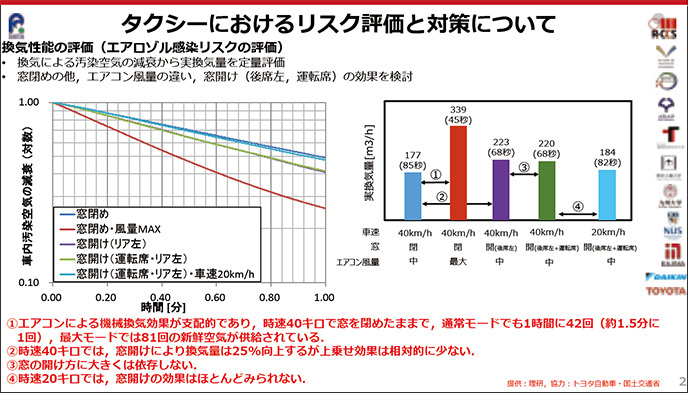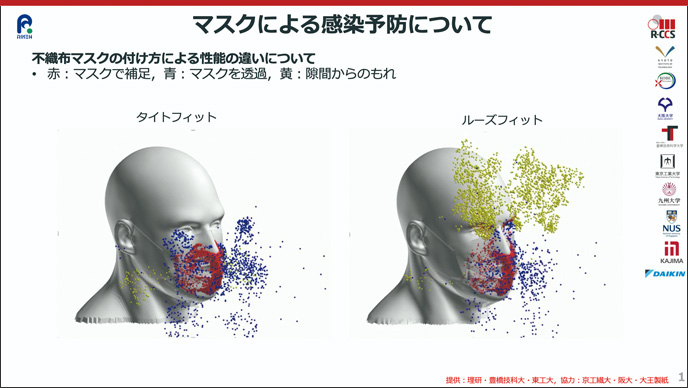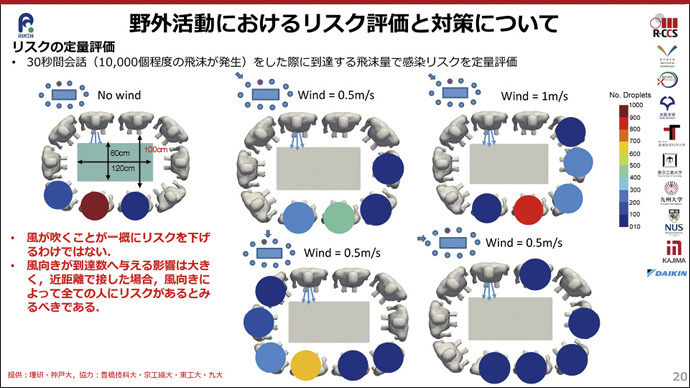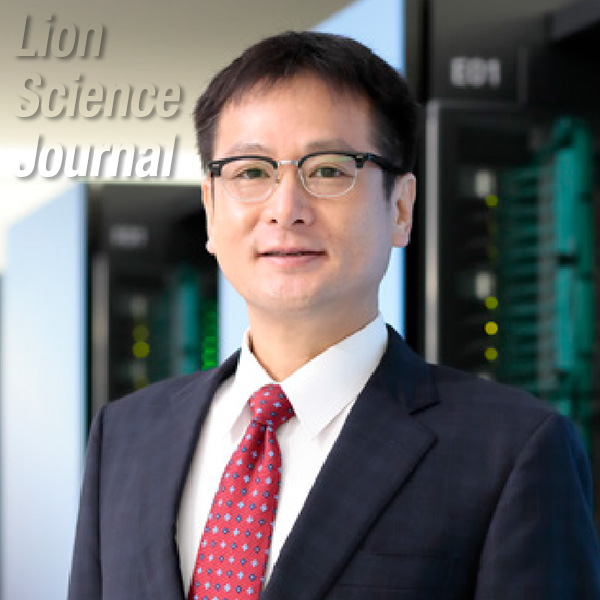The Three Elements of Infection: Routes of Transmission
We interviewed Prof. Makoto Tsubokura*, who has put forward predictions of viral droplet infection and proposed countermeasures for swift socioeconomic recovery based on simulations created using the world’s most powerful supercomputer, Fugaku.
These interviews were conducted in May 2021 by our research fellow, Dr. Murakoshi.
*The professors’ profile can be found at the bottom of this page.
Tsubokura: My field is fluid engineering. I started work relating to COVID-19 in April 2020. On April 7, 2020, RIKEN and the Ministry of Education, Culture, Sports, Science and Technology (MEXT) announced that they decided to make computing resources from the supercomputer “Fugaku” available to external researchers studying COVID-19 and countermeasures against SARS-CoV-2. I applied to participate. It started with the idea that the physical mechanism of droplet movement during a sneeze is the same as that of engine fuel ignition, so we could use the simulation program developed for analyzing automobile fuel injection for droplet analysis. The actual simulations are done by a team of 20–30 people, including experts in infectious diseases, viruses and saliva, as well as representatives of construction companies with expertise in indoor air conditioning, all working together to accumulate experiment data.
Murakoshi: What were some of the benefits of working with Fugaku, the world’s best supercomputer?
Tsubokura: Fugaku has up to hundreds of times the computing resources of its predecessor, the supercomputer “K computer,” and is capable of performing a very large number of simultaneous calculations. When our team began its work, COVID-19 was spreading rapidly, so we decided to issue press releases every month in order to propose the best infection prevention methods for real-life situations. We were able to do so swiftly thanks to the Fugaku. If we had been using the K computer, it would have taken a year or two to get the same results.
Murakoshi: Are there any other similar studies outside of Japan?
Tsubokura: There is research being done overseas, but most of it is one-off analysis at the lab level. Our team is analyzing quite a lot of different cases. For example, the scope of our analysis includes public transportation, such as sightseeing buses, local buses, taxis, commuter trains and airplanes. We even looked at ambulances. We also analyzed indoor spaces, such as offices, hospital rooms, classrooms, theaters and movie theaters. I believe that our team is the only one conducting comprehensive analyses based on many real-life situations.
Murakoshi: The COVID-19 research done by your team listed on the RIKEN website* provides lots of easy-to-understand information about the proper way to wear masks, ventilation, and the importance of putting up partitions as methods to prevent droplet-borne infection. Please tell us about any unexpected findings from your research.
Tsubokura: The way viral droplets and aerosols disperse was surprising. Distance is not inversely proportional to the number of droplets that reach a target—most droplets fall within one meter. However, aerosol particles, or aerosols, drift about two meters through the air, and can travel even further depending on the wind. It was fascinating to see the very different characteristics of the movement patterns of droplets and aerosols. Droplets smaller than 5μm are classified as aerosols. At this size, Brownian motion becomes dominant and particles aren’t influenced by gravity as much, so they drift along like clouds. The volume of aerosols and droplets decreases drastically after two meters. Two meters is the standard for social distancing, and I think that’s a good number.
Murakoshi: Looking at the size of droplets and aerosols, did you find that specific size distribution is fixed from the time of generation?
Tsubokura: Yes, I did. The size distribution is determined by where the droplets are generated. Only a small percentage of the droplets are actually generated in the oral cavity. Smaller droplets are generated when larger droplets split due to the vibrations of the vocal cords. This split can also occur even further down in the alveoli of the lungs. We also believe that the density of the virus in droplets and aerosols varies depending on where they are generated. There is only a small amount of virus in a single aerosol particle, so although we can’t explain why people become infected through inhalation, we have two hypotheses. The first theory is that because aerosols are smaller, they can get deeper into the lungs, where it’s easier for the body to become infected. The other theory is that an aerosol contains more virus than a larger droplet. Therefore, we are now beginning to develop an integrated infection risk assessment simulation that includes a numerical model of how immune cells react to different quantities of virus from the time droplets enter the body to the onset of disease.
Murakoshi: It sounds like this is going to lead to new discoveries that turn conventional wisdom on its head. Next, what are your thoughts on the importance of ventilation?
Tsubokura: Ventilation is extremely important. However, both indoor and automotive ventilation systems are well designed, so in some cases, opening the windows instead of using the ventilation system is not always better. For example, in a car, ventilation is most effective when the windows are closed and the air conditioner is running at maximum airflow in fresh-air mode, not when the windows are open (Figure 1).

A recording of the lecture can be viewed here. (accessed Sep. 15, 2021)
https://www.youtube.com/watch?v=267HdDdIywIMurakoshi: What about double masking, which is recommended by the United States’ Centers for Disease Control and Prevention (CDC)?
Tsubokura: Simulations showed that wearing one tight-fitting mask was just as effective. It’s more important to wear a mask that fits properly than it is to have two masks. Also, the wire should be molded to the shape of the wearer’s nose before the mask is put on, not after. This alone will improve the mask’s performance by 10%–20% (Figure 2), so please make it a habit. On the other hand, people may feel more secure when they wear two masks. Feeling safe is a big part of preparing for infection risks.

A recording of the lecture can be viewed here. (accessed Sep. 15, 2021)
https://www.youtube.com/watch?v=KGFQREnkxZ0Murakoshi: It’s true that we sometimes overreact or even misunderstand risks because of our desire to feel safe.
Tsubokura: The same goes for thinking that outdoors is safe. Even outdoors, the risk can be very high depending on the wind direction (Figure 3), but people sometimes assume that it’s fine as long as they are outside.

A recording of the lecture can be viewed here. (accessed Sep. 15, 2021)
https://www.youtube.com/watch?v=267HdDdIywIMurakoshi: It’s important to provide information that facilitates the correct understanding of the risks and leads to behavioral changes.
Tsubokura: Our team also decided to never issue statements containing shocking information that just scares people. Our simulations are always combined with countermeasures to provide the world with a correct, useful understanding of the infection risks.
Murakoshi: Lastly, please share your closing thoughts.
Tsubokura: As droplet infection occurs person to person, it is important for every individual to understand the infection risks and take countermeasures. There is no perfect solution, so try to combine several methods to reduce the risk of infection. Also, the measures should be sustainable, as extreme measures are difficult to maintain. Finally, COVID-19 is characterized by the fact that a single spreader can infect many people. The most effective measures are those that protect others from infection, rather than those that protect only yourself. I hope that all the readers remember that protecting people around them is key to lowering the risks to society as a whole and act accordingly.
Murakoshi: Thank you very much for sharing such valuable information with us.
Makoto Tsubokura,Ph.D.
Team Leader, RIKEN Center for Computational Science; Professor, Kobe University Graduate School of System Informatics

Prof. Tsubokura received his Ph.D. in Engineering from the Department of Mechanical Engineering at the University of Tokyo in 1997. In 1999, he became a lecturer at the Interdisciplinary Graduate School of Science and Engineering, Tokyo Institute of Technology. He became an associate professor at the University of Electro-Communications in 2003 and an associate professor at the Graduate School of Engineering, Hokkaido University in 2007. In 2012, he became a Team Leader of complex phenomena unified simulation research at RIKEN Center for Computational Science, a position he still holds. He has been a professor at the Graduate School of System Informatics, Kobe University since 2014, and has laboratories at both RIKEN and Kobe University under a cross-appointment system since 2017.
* Professor Tsubokura’s research related to COVID-19 can be viewed on the RIKEN Center for Computational Science website.
"Prediction of viral droplet infection in indoor environment and its countermeasures" (Japanese)